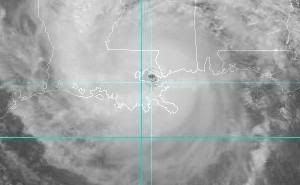As the late night of the 1st turns into the early morning of the 2nd, Erin has strengthened up to 50 mph, and 997 mb. Erin shows some signs of speeding up, now moving north-northeast at 8 mph. However, a forecast turn back to the west should occur, which should put Erin just south of Intercoastal City, LA in 120 hrs as a Category 2 hurricane of 100 mph. However, by the early afternoon of the 2nd, Erin is already up to 65 mph, and 990 mb. Now moving north at 10 mph, the forecast track has shifted to Erin being along the coast of Lousiana from 48-96 hrs, and being a Category 3 of 115 mph, and weakening to 90 mph by the time Erin moves back away from the coast towards Texas in 120 hrs.
However, by 11pm that evening, Erin becomes a Category 1 Hurricane, with winds of 80 mph and a pressure of 982 mb, and still moving due north at 11 mph. By early the morning on September 3, Hurricane Erin has strengthened up to 100 mph, a Category 2 storm with it's central pressure down to 965 mb. Since Erin is moving just barely west of north at 12 mph, the forecast track now has Erin making landfall near Port Sulphur in extreme Southeast Louisiana in 36 hours, as a Category 3 storm of 125 mph.
Now knowing how big a risk Erin is to downtown New Orleans, a mandatory evacuation order is issued by the mayor. As many struggle to evacuate during the day, many are astonished by Erin's intensification. By 5pm, Hurricane Erin has achieved Category 3 status, with winds of 120 mph and a pressure of 948 mb, and is moving towards the north-northwest at 11 mph. Three hours later, Erin has achieved Category 4 intensity, with winds of up to 135 mph and a pressure of 938 mb. By 11pm, the reconnaissance aircraft is reporting a stadium effect, and severe turbulence and lightning in the eyewall. They also report a central pressure of 926 mb, and flight level winds of 150 kts.
As the late night of September 3 becomes early morning September 4, Hurricane Erin has winds of 155 mph, and a 925 mb pressure, moving northwest at 9 mph. As people wake up in the early morning of September 4, all TV and Cable News Networks give out the latest. Hurricane Erin, a Category 5 Hurricane with winds of up to 165 mph and a pressure of 921 mb, is about 120 miles East-Southeast of New Orleans, LA, moving west-northwest at 7 mph. Hurricane Erin's eye on radar shows a deep red eyewall 15 miles wide, tightening. Landfall is expected sometime in the early-mid afternoon.
Forecasters are once again amazed when reconnaissance aircraft reports a central pressure of 915 mb, and sustained winds of 175 mph around 12pm Eastern, 11am central. Hurricane Erin, now moving just north of west at 9 mph, is moving over the southern area of Lake Borgne. Just as reconnaissance is leaving the eyewall, they find a 913 mb pressure, and flight level winds of 178 kts in the Western Eyewall. At 2pm Eastern, 1pm Central, Hurricane Erin makes landfall in New Orleans, LA as a Category 5 hurricane with winds of 180 mph, and a pressure of 913 mb.


A storm surge of over 20 feet pushes water into Chalmette, and even into downtown New Orleans. However, winds push the water from Lake Pontchartrain south, into the towns of West End, Seabrook and even into Downtown. Areas of Laplace, Reserve, Matairie, Kenner, Frenier, and all surrounding areas are flooded, including the streams and rivers and bayous.
Winds are recorded in downtown to 140 mph, before the instrument failed. An unofficial gust to 185 mph was recorded in New Orleans by a storm chaser. The chaser also recorded an unofficial pressure of 917 mb. The chaser was in the eastern eyewall at the time, and did not experience the worst, which was in the western eyewall. Although all instruments were destroyed, winds are estimated to have been sustained at 180 mph for a short period of time over the New Orleans and Matairie area. Winds probably gusted as high as 210 mph in these areas as well. Winds were sustained at up to 135 mph in Laplace and a gust to 156 mph was recorded.
As Erin weakens to a Tropical Depression 36 hours later, waters begin to recede. Those who evacuated were thankful, those who did not were either lucky, or parished. Hurricane Erin goes down in history, as the costliest hurricane in US History. The damage is inconceivable in some areas, with no debris, just flat land where homes used to be. The water has left snakes and bugs and animals loose, into towns. Some people die from being ill from dirty water, others are bit by wild animals, and suffer. The biggest relief effort in US History is put in place. The national guard cracks down on looters, while many go to nearby shelters.
Louisianians will never forget Erin, and the scar it forever left on New Orleans. Places like Covington, Laplace, Matairie, and Reserve are stuck in people's minds as the cities that will take years to recover. Erin was the Big One, for the Big Easy.
A Hurricane like this will happen one day. It may be a Cindy, or a Dolly, an Ike or an Erin...and you must be prepared. Every storm, every season, everytime.
Made by Mike Naso.
Leave a comment on what you thought of the story if you like.




